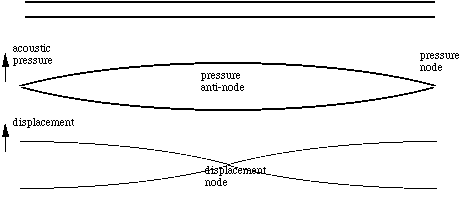| Open Pipe |
"In non-electronic instrument, the stable, controlled vibration is produced by a standing wave." http://newt.phys.unsw.edu.au/music/ Since the ends of a flute are open, they are close to atmospheric pressure. The standing wave is sketched below. http://newt.phys.unsw.edu.au/music/ The Vibration in pressure is the bold line, the fine line represents the displacement of the air molecules. Air molecules are free to move in and out at the open ends.
The above picture is a harmonic series and notes with pitches shown.
Since the flute is open to the air at the ends the total pressure is close to atmospheric pressure. So the acoustic pressure is close to zero. In order for a wave to satisfy this condition the longest standing wave is one in which it's wavelength is twice as long as the flute! The pressure inside the tube does not have to be atmospheric. |
http://newt.phys.unsw.edu.au/music/ The university of New South Wales, Sydney, Australia reports on the natural variation of the air due to pressure: "And indeed the maximum variation in pressure (the pressure anti-node) occurs at the middle." |


